Gold & Precious Metals
Wall Street powerhouse Goldman Sachs has recently reiterated its negative view on gold, which it has held for the past year. However, it is now doubling down on this view and advising clients to actually go short the metal. Jeff Currie, head of commodity research at Goldman noted “Our target is really driven by the view that we think that the Fed will ultimately be the dominate force here and put more downward pressure [on prices]”.
While I am in agreement with Goldman that the Fed will be the dominant force behind the price of gold, I believe the central bank will soon be back into the QE business, rather than raising interest rates and crushing the dollar price of gold.
Here’s why:
Since Nixon closed the gold window in 1971, gold has made an impressive move upward from its fixed price of $32 an ounce, to where it sits now around $1,250. But few seem to grasp what actually causes gold to move higher. An increase in the gold prices occurs when the market becomes convinced that a currency will lose its purchasing power due to central bank-induced money supply growth and real interest rates that have been forced into negative territory. And nothing convinces a market more of a rising gold price than when debt and deficits explode.
But while the parabolic move higher in gold from 2009 to 2011 did contain a period of low nominal interest rates, real rates did not fall. And, the surging gold price was not accompanied by a growing money supply either. In fact, the growth rate of M3 plummeted during 2009 thru 2010 — it wasn’t until 2011 that the money supply rebounded. So what would explain the steady move in gold from $800 to $1,900 per ounce during that time period? The gold price simply got ahead of itself because the market feared that out of control deficits would force the Federal Reserve into an unending cycle of debt monetization, which would engender a protracted period of negative real interest rates, booming money supply growth and inflation.
However, those fears were temporarily ameliorated by the reduction of Federal Budget deficits starting in 2011. This is because the Fed was, ironically, able to temporarily re-engineer asset bubbles, while sending borrowing costs lower, causing revenues to increase and expenditures to decrease. Annual deficits fell from $1.3 trillion in 2011, to $500 billion today. Adding to the gold market’s recent woes is the specious belief held by U.S. dollar bulls that the Fed will be aggressively raising interest rates while the rest of the world is cutting rates. This is the explanation to why gold and gold mining shares have suffered mightily during the past three years.
Today, the equity and bond markets have positioned themselves for the best outcomes of all possible scenarios. These markets are assured that the Fed can painlessly exit QE in October and real interest rates will rise with no ill effects on the economy. The pervasive belief being that US bonds, stocks and dollars will be the sole beacons of economic hope in an otherwise slumping worldwide economy; and, having complete faith that budget deficits will continue to shrink.
I don’t buy any of it, and here are the reasons:
Last week we learned that mortgage applications plunged to a 14 year low. This is because home prices are still so unaffordable that just a slight tick higher in interest rates is enough to stall both potential home buyers and borrowers looking to refinance their loans. This confirms that after six years of unprecedented Fed manipulation of markets, our economy has become hypersensitive to the slightest interest rate blip. It also supports my contention that the rise in rates which occurred during the second half of 2013, was much more influential on the first quarter’s negative 2.1 percent GDP print than what can be attributed to snow. Our economy is not anywhere near strong enough to sustain growth during a rising interest rate environment. And is why the Fed won’t venture very far into this game.
Furthermore, economies in Europe and Japan are in recession, while the once mighty emerging market economies are flailing. As their respective Central Banks frantically print money, the US dollar is soaring due to the belief that the US economy will remain unscathed from a global economic slowdown. But, the belief that the U.S. economy will stand alone on a pristine island, while Europe and Japan sinks into the sea, is just as preposterous and unprofitable as the belief held back in 2008 that economies around the world would remain untouched by the U.S. housing meltdown.
The markets also seemed to shrug off last week’s disappointing jobs report as an anomaly. Perhaps a colder-than-normal August is a good scapegoat. But this week, Janet Yellen gave us an interesting glimpse into the Fed’s view of the jobs picture with her “Labor Market Dash Board”. It showed that only three out of nine metrics regarding the labor market are better than they were prior to the start of the Great Recession. Investors should think again if they believe the Yellen Fed will be aggressively raising rates and boosting the value of the dollar given the labor market’s already-fragile condition.
Most importantly, the tide of shrinking budget deficits is about to turn. For instance, since 2011, we have seen a significant reduction in defense spending (down 5.5% during 2014 alone), due to the drawdown of troops in Iraq and Afghanistan. And although we have yet to learn the full costs associated with Obama’s plan to destroy ISIS–we can safely assume it will be very expensive.
Adding to this, is the drastically underestimated cost of Obamacare. Insurance risk pools failed to get the proper demographic mix, and the Cadillac tax–delayed until 2018–has companies scheming to redesign existing plans in order to avoid these taxes. Add to this the unexpected costs of illegals flooding the border, demographics moving far out of favor, and an increase in interest rates that will drive up debt service costs, and you can see why deficits will rise. But nothing adds to the deficit like a recession. Our asset-bubble addicted economy faces another reduction in GDP growth very shortly. This factor alone will send deficits north of $1 trillion in short order.
Faced with a worldwide economic slump, central banks remain the only game in town. And today’s central banks, determined to smooth out every hiccup in the economy, only have one answer–print money. When all you have is a printing press, every problem looks like a monetary crisis.
The Fed will not be raising rates anytime soon. To the contrary, Ms. Yellen will soon be forced back into the money printing business in an attempt to; force higher money supply growth, push real interest rates further into negative territory, keep the dollar from rising, and to make sure debt service payments remain under control.
Soon we will have a perfect storm in which gold will rise. The next phase in the gold bull market will include the four conditions of; negative real interest rates, rapid money supply growth, a falling dollar and skyrocketing deficits. Investors that have the foresight to realize this opportunity today stand to benefit greatly in the near future.

Sentiment Shifting for Gold Bugs
Posted by Gary Tanashian - NFTRH Premium
on Thursday, 11 September 2014 0:14
Warning… Condescension ensues…
“There are worse things that could happen than filling a gap and scattering the wrong kind of gold bugs back out. Then it would be up to the longer-term charts to do the heavy lifting if the daily does fulfill this downside potential.”
The gap was filled, the top end of the anticipated support zone was reached and indeed, the wrong [i.e. momentum players] kind of gold bugs are scattering back out. The hard sell down on Thursday was very likely due in large part to the selling by traders with a fetish about gold as a geopolitical or terror hedge.
We should continue to tune out these people and while we are at it, tune out the ‘Indian wedding season’ and ‘China demand’ pumpers in favor of real fundamentals like gold’s relationship to commodities and the stock market, the Banking sector’s relationship to the broad market, Junk Bond to Quality credit spreads and US Treasury bond yield relationships.
It’s boring stuff compared to all that demand in China, Modi’s pro-gold regime in India and of course how we are all going to go down the drain amidst war, terror and an age of global conflict unless we have a ‘crisis hedge’. The only terror gold investors should care about is that perpetrated upon paper/digital currencies by global policy makers.
So last week was good in that it blew out those who were hanging on through the 2 month long grind that did indeed turn out to be short-term topping patterns. I don’t mind telling you that my patience was tested by the bullish spirits, especially on up days with Ukraine in the headlines. I did not think it would take 2 months to resolve, but every time the sector looked like it would crack, a new geopolitical flashpoint would show up in the mainstream financial media.
That condition is now being closed out. Taking its place could be a bottom of at least short-term significance (i.e. to a bounce). We have a fundamental backdrop that is not fully formed and a big picture technical backdrop that has degraded in gold and silver and is not proven in the equities. So whether we bounce only, go bullish for an extended rally or even bull market, or (and it’s still on the table folks) fail into the ‘final plunge’ scenario, we are dealing in potentials, not confirmed trends.
Moving on let’s check sector sentiment.
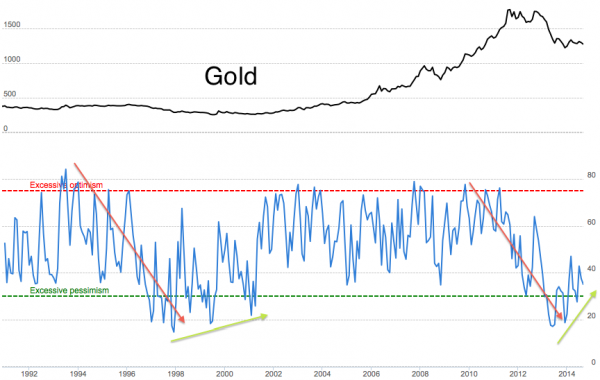
The current hook down in gold’s Optix (Sentimentrader.com’s aggregated Public Opinion data) is correcting recent surges in optimism. This is coming amidst a small positive trend. ‘Uh oh, dumb money is getting positive!’ think contrarians anxiously. But the historical view shows that the Optix rises in the initial stages of a bull market.
So I am not calling a new bull market here, but I am calling a condition to one, which is a positive trend (subject to ongoing corrections like the current one) out of deeply depressed levels by the Gold Optix.
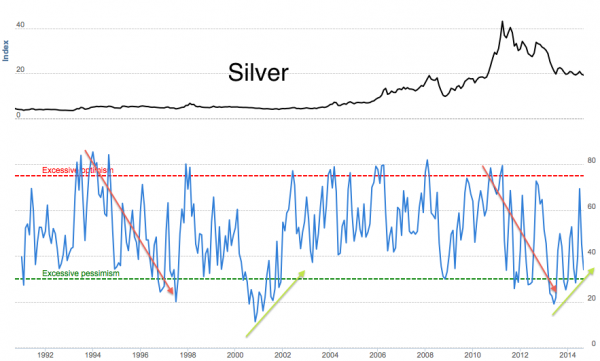
Silver is even better, as it became way over loved, conveniently right at the time we noted severely over bought technicals in nominal silver and in its relationship to gold. If we were to go strictly by this graph (which we of course will not) it looks like silver is ready to bottom and turn up.
A view of how unhealthy silver’s sentiment backdrop became recently comes from the most recent spike in the Optix to near the red line, while the price of silver barely went anywhere. Again, we cannot make foolproof claims about what lay ahead but what we can claim is that a bearish condition is gone, replaced by a more bullish one.
The bottom line is that while gold’s technical situation was compromised last week and silver is testing major support one more time (4th) than I personally find agreeable, the sentiment backdrop has become more favorable. Not shown above are the Commitments of Traders data, which improved again last week, but have room to improve further.
This segment will probably be released as a public article to maybe try and convert one or two more people away from the stuff talking about weddings and war and corresponding sentiment traps that people in this sector all too often fall into from a bullish perspective.
Gold is getting drubbed in ratio to the US stock market and in the face of a strong US economy. Those are facts and also fundamental considerations. In seeking a macro pivot phase, we are looking ahead to a potential time of change, but easy connect-the-dots analysis is not going to bring such a phase on, no matter how often the wrong kind of gold bugs click the heels of their ruby slippers.
We’ll clip it here and move on to the nuts and bolts technical and fundamental analysis.
[end excerpt, new material follows]
Mark Hulbert: Gold may be a buy as investors turn ever more bearish
Okay, Hulbert’s HGNSI is on board the contrary theme as well. That only reinforces matters. Gold trend followers are now hyper bearish, which is good because this is one sector you buy when it is reviled, not cheered for.
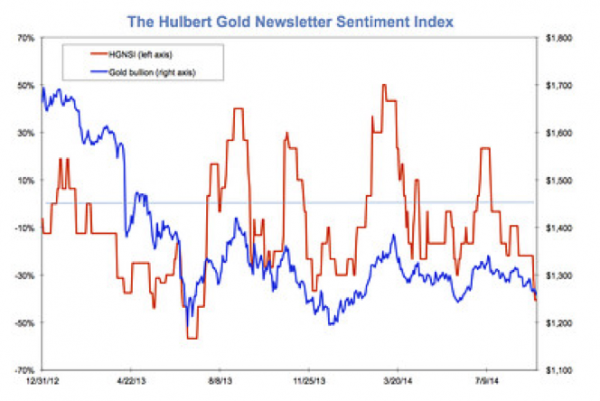
But let’s also keep in mind the reason why said trend followers lurched bearish; a very real technical breakdown per this overly simplified chart of a Symmetrical Triangle breakdown. That’s what’s got everyone freaked out. Support at 1250 must hold and gold needs to reverse back above 1275 and then we could have a view of a bear trap getting sprung amidst over done negative sentiment.
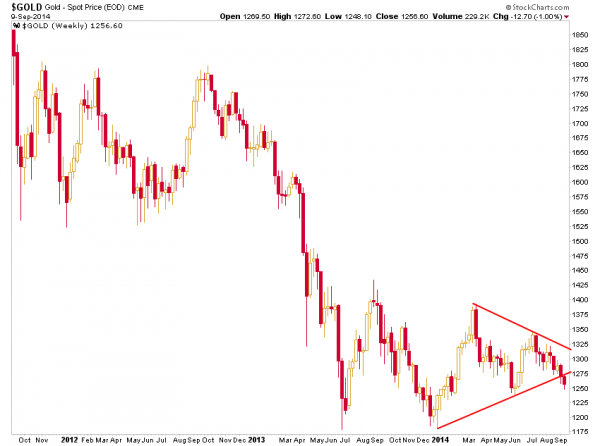
NFTRH 307’s opening segment, dated 9.7.14: From a post on the HUI at the site last week
Subscribe to NFTRH Premium for your 25-35 page weekly report, interim updates (including Key ETF charts) and NFTRH+ chart/trade ideas or the free eLetter for an introduction to our work.

Single Most Bullish Precious Metals Factor Imaginable
Posted by Andrew Hoffman - Miles Franklin Ltd
on Wednesday, 10 September 2014 13:58
Since my sophomore year in college what I’ve loved most is analyzing economics, finance and corporate fundamentals. The 1987 crash occurred when I was still a clueless high school senior, but by the time I started my first internship in 1989 – at Paine Webber, cold calling certificates of deposit yielding 6% – I was reading the Wall Street Journal daily and daydreaming of working at Goldman Sachs. My first decade in the business was highly optimistic, but by the time Goldman actually offered me a job in May 1998, I already disliked them so much, no amount of money could have sealed the deal. Instead, I worked for Salomon Smith Barney – owned by none other than what has turned out to be the nation’s most destructive financial force outside JP Morgan and Citigroup.
In the ensuing 16 years, the business I once loved was utterly destroyed by the “1%” running such firms; with Citigroup’s own Sandy Weill spearheading the 1999 repeal of Glass-Steagall; which, in hindsight, was the single most destructive economic act of our lifetimes. By the time I left Wall Street in 2005, equity research had been long discredited; and by the time I left mining investor relations to join Miles Franklin in 2011, the Wall Street institution was permanently lost to corruption. More ominously, its traditional economic roles of capital formation and allocation were no longer necessary; as following two decades of offshoring “productivity” gains and the emergence of Eastern hemisphere powers like China, America’s economic empire was in irreversible decline. This is when TPTB realized the only way to maintain the status quo – or more appropriately, “kick the can” that last mile – was exponential growth of money printing, market manipulation and propaganda. This is how dying empires collapse; and oh yeah, fiat currency Ponzi schemes in their terminal stage.
Today, 25 years from that Paine Webber internship with CD yields at 0% and in danger of turning negative, I still love financial analysis more than anything. However, now that markets are rigged, my finance degree, CFA degree and 15 years of buy- and sell side experience have been rendered moot. Thus, I’ve been forced to build an “alternative” analytical mosaic; which fortunately, is not immune to the forces of “Economic Mother Nature.” Using it, as well as common sense, I have been consistently correct in my expectations of global economic growth; and via this mosaic, I have never been more negative about the world’s short- and intermediate-term outlooks. As for the long-term, I have not the slightest idea when prosperity will return. However, what I do know is that until today’s global fiat Ponzi scheme inevitably implodes, prosperity is not possible. This is why I hold 90% of my liquid net worth in physical gold and silver; as when the dollar, Euro, yen and other fiat trash are dramatically devalued in the coming years, they are theonly assets guaranteed to maintain purchasing power.
Which brings me to today’s very important topic. Not that we haven’t spoken of it countless times before; but as a new world-threatening “episode” has emerged, with the prospect of violently expanding in the coming months it appears to be a good time to speak of it. Which is the economically catastrophic impact of fiat currency volatility, particularly relative to the dying universally despised “dollar.”
Yesterday, I read an article titled “Germany loses the battle for the ECB, as QE goes global.” Essentially, it was referring to the virulent “final currency war” we have been writing of for years. In other words, in the final cancerous stage of the fiat Ponzi scheme, global economic growth has been so badly crippled, politicians and Central bankers are resorting to dramatic currency devaluations in the hope of gaining all-important manufacturing market share – and thus, “jobs.” The fact that inflation erodes the value of such gains and prompts draconian retaliation by other nations – in the form of “competitive currency devaluations” – bothers them not, so long as said jobs are produced.
Unfortunately, this deadly “zero sum” game is infamous for not only destroying capital, but prompting economic – and often military – wars. This is why global unrest has not been this ubiquitous in generations, and why World War III is just one “black swan” event away. Currency volatility makes it nearly impossible to build a long-term corporate strategy and wreaks havoc with earnings – particularly, at companies whose financial departments are too “cute” with hedging strategies, which by and large fail miserably. This is the legacy of a world gone mad in which not a single currency is backed by anything but the “full faith and credit” of corrupt, uncaring, financially unsophisticated governments which cede unlimited money printing authorization to bankers incentivized to generate inflation for their own interests.
Regarding economic activity, what more damning statement can be made than the below chart, of the supposedly strongest sector of the supposedly strongest nation; let alone,this fantastic article by David Stockman of the true state of U.S. employment decay? Meanwhile, Europe’s widely watched Sentix Investor Confidence Index plunged this morning from 2.7 in August to -9.8 in September, whilst Japanese capital spending was reported to have experienced its largest decline since the “deer in headlights” economic trough of 1Q09. In other words, “it” appears to be starting – which is why you mustconsider protecting your assets as soon as possible!

In our view, the “single most bullish PM factor imaginable” is the catastrophic economic dislocation, political and social tension and inflation caused by the currency volatility inherent in all fiat currency regimes. Such volatility increases as their inevitable end approaches; and the current “emerging market” currency plunge – catalyzed by Draghi doing “whatever it takes,” and the Bank of Japan on the verge of same – is the fourth such episode in the past five years. In last year’s “Inflation and Arab Spring,” we wrote of how such volatility – which always effects lesser “non-reserve” currencies first – creates massive inflation surges, nearly always followed by social unrest. This time around with sovereign balance sheets and economies in dramatically worse shape, we shudder to think how inflationary – and potentially, hyperinflationary – the coming round of massive Central bank money printing will be. And yes, that goes for the “tapering” Federal Reserve as well.
Is this week’s U.S. rate surge (albeit, quite modest in absolute terms) due to better economic prospects (NO!), Fed manipulation or otherwise? Who knows; but as is becoming quite evident, next week’s Scottish independence referendum has emerged as quite the “black swan” candidate. Amidst such a capricious global economic situation, such an event could send shock waves through financial markets – particularly the other “supposedly” strong nation, England. Of course, in reality, England’s economy is in the same sorry shape as ours – with its only “bright spot” being the same high-end real estate bubble as the one the Fed has created here; which, by the way, was deflatingbefore the potentially catastrophic “Yes Scotland” movement gained steam. More importantly, the inevitable secession – and expulsion – movements I first wrote of in 2011’s “unprecedented” are clearly gaining momentum; which is probably why Spanish bond yields had their biggest spike in 15 years this week – and why nations like Italy, states like California and various other municipalities are in danger of monstrous yield spikes in the coming months.
In the past month, the “dollar index” has risen modestly from 81 to just over 84; in other words, solidly within the 70-90 range it has traded within for the past decade. However, the inflationary impact of such a move cannot be underestimated. In the case of Europe, the euro’s recent plunge will likely generate the inflation Draghi so desperately wants, even before ECB QE starts in October. In Japan, which not only broke through long-term support at 105/dollar this week, but 106/dollar as well, it may well be that the “real Yen bomb starts now.” And as for U.S., said dollar “surge” will cause dramatically weaker earnings for the multi-national corporations dominating the economic landscape; which, given unparalleled equity overvaluation and economic data “decoupling” could prove catastrophic to TPTB’s “recovery” illusion,” no matter how hard their “PPT teams” huff and puff.
Such dramatic economic shifts, in turn, will warrant retaliation by the Fed – in the form of further monetary easing, yielding increased money printing by the countless nations “pegged” to the dollar – such as China; and so on and so on. In other words, the latest round of “emerging market” currency collapses – which cumulatively, have shaved nearly 40% of purchasing power versus the dollar in the past three years – has the potential of catalyzing the “big one”; from which, when it commences, there will be no possibility of reversal or escape from regional hyperinflation.
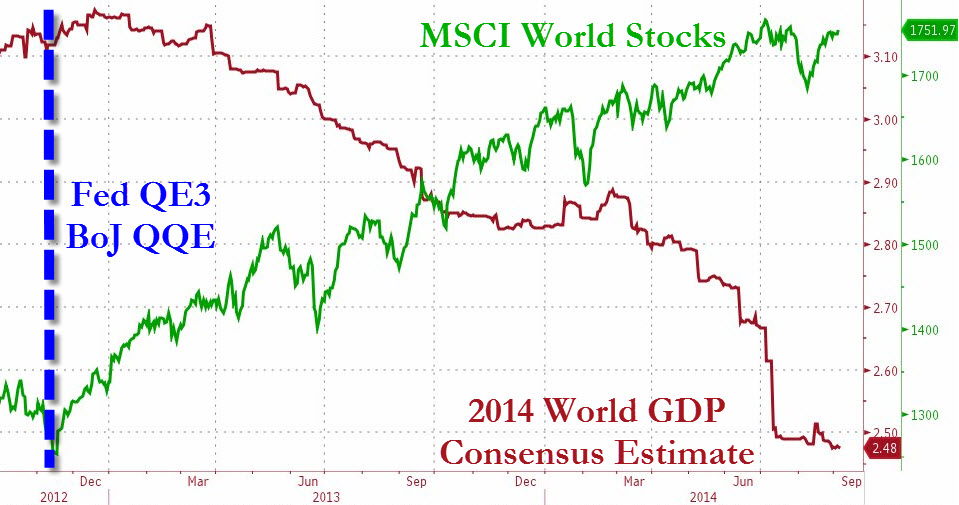

And when the “big one” inevitably occurs, there will no longer be even the slightest doubt of what the true definition of “inflation” is. Or, for that matter, that the “dollar index” is not how one should measure the dollar’s strength – but instead, the real items of value it buys or won’t buy – such as history’s only real money, physical gold and silver. To that end, we hope you will consider protecting yourself before it’s too late; and if you do, that you’ll give Miles Franklin celebrating our 25th year of business the opportunity to earnyour business.
Andrew C. Hoffman, CFA
Marketing Director
Miles Franklin Ltd.

- The QE program created substantial hedge fund interest in gold-related ETFs. Unfortunately, QE never created the inflation the funds had anticipated.
- That’s because commercial banks held the QE money they received, “tight to the chest”, rather than loaning it to businesses and consumers.
- In a nutshell, by enlarging the money supply while GDP was falling, the Fed created deflation.
- So, if the Fed were to shrink the money supply now, or at least reduce its rate of growth, while GDP rises, and banks start making loans with their “QE booty” at the same time…. is that inflationary?
- The answer is yes.
- The taper is inflationary, because it stops the wild growth of the moneysupply, and does so as GDP grows and wages rise.
- I’ve labelled 2014 the “year of transition”, from deflation to inflation. Most gold analysts are sure gold is either forming a base or a consolidation pattern, but neither scenario really fits with market fundamentals.
- Sideways price action, for an extended period of time, is what is suggested by the “transition period” fundamentals.
- Gold’s price action was a bit soft in recent weeks, but not because Western investors are selling or bearish. It’s because demand from China and India is not strong enough to overwhelm mine supply and scrap supply. It’s a case of “close, but no cigar!”
- Please click here now. This weekly bars chart shows gold is near buy-side HSR (horizontal support and resistance) that sits around the price of $1240.
- Leveraged traders could buy near that price, with a tight stop loss, and long term accumulators can do the same thing, but without the leverage or the stop loss.
- Note the position of the price stoker oscillator. It’s common for the lead line to reach the 10 area, before an intermediate trend rally occurs.
- Giant value-oriented mutual funds can easily overwhelm hedge fund naked selling of gold stocks, with their buying, if they are inclined to buy. At about $1250, gold is trading in the upper part of the $1000 – $1300 cost of production zone. Any decline in the price will attract more and more of these value funds, and they will buy with ever-larger size.
- A decline under $1180 would undoubtedly be accompanied by hedge fund shorting, but they may find their actions are largely offset by value fund buying, resulting in sideways price action between $1150 – $1350, for quite a long period of time.
- The Western gold community is faced with a situation where the West is transitioning, slowly, from deflation to inflation. At the same time, China and India are transitioning into a “gold jewellery era”, fuelled by the enormous industrialization of their gold-hungry populations. These transitions take time. They are not rocket launching bases. Nor are they trap doors to Hades.
- A long period of sideways price action is dictated by every gold price driver, except for geopolitics. On that note, please click here now. Geopolitics is the current black swan that can drive gold higher. If ISIS is able gain a footing in Pakistan, and attack Indian forces in Kashmir from the Pakistan side, nuclear war is possible, and arguably likely.
- The disputed border area of Kashmir is probably the most dangerous area in the world, and incidents of gunfire have increased there, in the past few months. To understand the basic facts about this potential gold price driver, please click here now.
- Also, September 11th is just two days away. There are rumours of missing passenger planes in Libya that could be used for a terrorist “anniversary” attack. It’s not something to be obsessed with, but it is a reason to own a core position in gold bullion.
- Please click here now. Silver is unlikely to rally before gold does, and it may or may not outperform gold. The price stoker has declined from about 95 to 16, suggesting that both accumulators and traders should report for buy-side duty!
- I don’t think bullion investors should spend much time trying to figure out whether silver will outperform gold or not. Ultimately, a bullion investor is drawn to one metal or the other, and it’s really a matter of personal preference.
- If an investor likes more real risk coupled with more potential reward, they should probably be invested in silver. More conservative bullion investors should focus on gold. I own both. Over the past week, I bought more using my “PGEN” (my systematic capital allocator), in some size.
- Nobody in the Western gold community is getting any younger. If gold is set to trade sideways for a year (or longer), rather than look like somebody that just fell off the turnip truck, I want to get paid to wait. I maintain a separate brokerage account that focuses directly and indirectly on dividend stocks and funds, in the precious metals sector. Income is important. I also operate a website dedicated to dividend-focused precious metals enthusiasts. Personally, I like to get paid every month. Quite simply, the bird in the hand is often worth many birds in the bush. I check my account once a week, for the arrival of regular and special dividends. For details about the website, please send an Email to stewart@gudividends.com. Thank-you.
- Please click here now. While the past couple of days have been disappointing for gold stock investors, my price stoker oscillator has finally arrived at the 20 area, on this GDX daily bars chart. I’m a light buyer here in the $24 area, which is also a key Fibonacci retracement line.
- While the outlook for the price of gold stocks is generally sideways, even minor weakness is likely to be bought fairly aggressively, by value-oriented funds, bringing much-needed stability, to the entire precious metals sector!
Sep 9, 2014
Stewart Thomson
Graceland Updates
website: www.gracelandupdates.com
email for questions: stewart@gracelandupdates.com
email to request the free reports: freereports@gracelandupdates.com
Tuesday Sep 9, 2014
Special Offer for Money Talks readers: Send an email to freereports@gracelandupdates.comand I’ll send you my free “Golden Cops” report. I analyse the merits of the top five gold stocks most likely to do well and make acquisitions, in the “cost of production” zone!
Graceland Updates Subscription Service: Note we are privacy oriented. We accept cheques. And credit cards thru PayPal only on our website. For your protection we don’t see your credit card information. Only PayPal does.
| Subscribe via major credit cards at Graceland Updates – or make checks payable to: “Stewart Thomson” Mail to: Stewart Thomson / 1276 Lakeview Drive / Oakville, Ontario L6H 2M8 / Canada |
Stewart Thomson is a retired Merrill Lynch broker. Stewart writes the Graceland Updates daily between 4am-7am. They are sent out around 8am. The newsletter is attractively priced and the format is a unique numbered point form; giving clarity to each point and saving valuable reading time.
Risks, Disclaimers, Legal
Stewart Thomson is no longer an investment advisor. The information provided by Stewart and Graceland Updates is for general information purposes only. Before taking any action on any investment, it is imperative that you consult with multiple properly licensed, experienced and qualifed investment advisors and get numerous opinions before taking any action. Your minimum risk on any investment in the world is 100% loss of all your money. You may be taking or preparing to take leveraged positions in investments and not know it, exposing yourself to unlimited risks. This is highly concerning if you are an invetor in any derivatives products. There is an approx $700 trillion OTC Derivatives Iceberg with a tiny portion written off officially. The bottom line:

Super Mario Shows His Hand
Posted by Robert Levy - Border Gold
on Monday, 8 September 2014 13:46
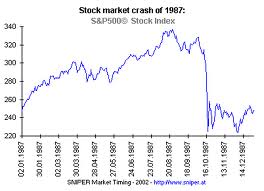 Mario Draghi and the European Central Bank (ECB) shocked financial markets this week when they yet again revealed they were prepared to further combat a stagnating European economy. They announced they were lowering three key policy rates to their ‘lower bound’ and unveiled an unconventional QE style stimulus program to purchase non-financial private sector debt. Unfortunately, the implicit message delivered was that their policy options are becoming exhausted, and consequently further accommodative policy saw the euro fall over 2 cents on Thursday against the US dollar.
Mario Draghi and the European Central Bank (ECB) shocked financial markets this week when they yet again revealed they were prepared to further combat a stagnating European economy. They announced they were lowering three key policy rates to their ‘lower bound’ and unveiled an unconventional QE style stimulus program to purchase non-financial private sector debt. Unfortunately, the implicit message delivered was that their policy options are becoming exhausted, and consequently further accommodative policy saw the euro fall over 2 cents on Thursday against the US dollar.
The trimming of the key policy rates is only somewhat significant as they have taken their deposit rate, the rate of interest charged to financial institutions, further into negative territory. Ideally, no financial institution is going to take a loss or pay the ECB interest to hold their cash overnight, and ultimately it’s a facility that will not be used. In theory, it’s to create the disincentive to deposit funds with the ECB, and instead incentivise them to make money available to the business sector.
The other key lending rate to focus on is the refinancing rate, which the ECB cut to 0.05 percent. This is similar to where the Federal Funds Rate in the US sits between 0 and 0.25 per cent, and at 1 per cent in Canada. And again, a marginal 10 basis point cut does not make a huge material difference to incentivize banks to now borrow more and make loans, but it almost acts as part of a last resort move for the ECB attempting to stave off a deflationary environment.
These further rate cuts seem like a last resort tool for the ECB in terms of utilizing their conventional policy tools, which clearly are not providing the incentives with the liquidity to spur economic activity in the respective economies. With powerhouses like Germany actually seeing GDP growth contract in the latest quarter, and Italy now entering a triple dip recession, this crisis still very much drags on in Europe. But the question is, as monetary policy sees a diminishing impact, can further accommodation prolong the structural reforms so desperately needed?
Mario Draghi said at his press conference that these measures will only work if they come with the structural reforms on the fiscal policy side, and that is left up to the individual European governments. But as the ECB looks to protect its mandate of price stability in the euro, similar to that of the US Fed, policies in the last week have entered the experimental phase as they begin their targeted bond purchases.
The biggest shortfall of monetary policy in Europe was that it was not filtering through to the businesses that hire workers and advance the economy. As was seen by continuously lowering policy rates, credit has largely remained unavailable to the small and medium size enterprises. The announcement of purchasing asset backed securities is the first step in how the ECB plans to combatthis.
As Draghi dictated and the market reacted, this is a policy that ultimately weakens their currency, where on Thursday the euro reacted and fell to its lowest level since July of last year. Many are drawing comparisons to this and the Fed’s Quantitative Easing, or Abenomic’s and its three arrow approach in Japan. Moreover, the ECB is really the last major central bank to join the experimental policy party, and whether they will be successful is not the question, as six years into recovery, investors have learnt the hard lessons of not betting against central banks. Instead, what is the cost of experimental policy and ongoing government malaise?
A question we are still awaiting an answer to here in North America.


-
I know Mike is a very solid investor and respect his opinions very much. So if he says pay attention to this or that - I will.
~ Dale G.
-
I've started managing my own investments so view Michael's site as a one-stop shop from which to get information and perspectives.
~ Dave E.
-
Michael offers easy reading, honest, common sense information that anyone can use in a practical manner.
~ der_al.
-
A sane voice in a scrambled investment world.
~ Ed R.
Inside Edge Pro Contributors

Greg Weldon

Josef Schachter

Tyler Bollhorn

Ryan Irvine

Paul Beattie

Martin Straith

Patrick Ceresna

Mark Leibovit

James Thorne

Victor Adair

